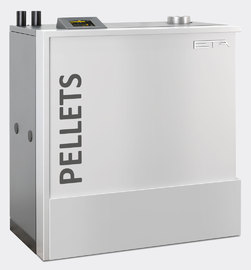Off Grid Heating
When designing and installing off grid heating systems there a few additional considerations that do not apply to mains connected buildings. The first and most important one to bear in mind is that you have to design around the fact that the electricity supply may not be continuous. In winter when you need the heating the most, you are also likely to be short of electrical power from renewable resources. In these situations it is especially important that everything 'Fails safe'. By that I mean that if the electricity fails the boiler can still transmit heat and there won't be problems with boiling dry or excess pressure building up.
To ensure off grid renewable heating systems are as 'fail safe' as possible it is a good idea to reduce the amount of electrical items in the system. An example of this methodology would be to use a 'buffer' tank of a capacity to match the heat source. If the electricity supply were to go off, the buffer would provide somewhere for the heat to go (by natural circulation), instead of causing problems with the boiler.
Having a 'combination' buffer and thermal store means that hot water services can continue as long as there is heat in the buffer – even when the electrical supply is interrupted. Other methods involve external heat exchangers, but where you have a heat exchanger you also have two pumps and associated controls. Heat exchangers and pumps are hard to arrange in way that will 'fail safe' as mentioned earlier.
The other advantage to having a large volume of storage is that it can prevent the heat source turning itself on and off too many times (I'm thinking pellet boiler here) or reducing the number of 'burns' that you need to do on a log burner. If you think of a gas or oil 'combi boiler' it can fire up immediately and produce heat, it can cool down quickly too, and this is how it is designed to run. A wood burner or pellet stove cannot do this, it takes time for them to switch on and off ( a process known as 'cycling') so it is important for the store to be sized to match their capacity. A minimum ( and still not ideal )'burn' time on an automated pellet stove would be 20 minutes. On a 12kW system that would equate to around 4 kilowatt hours (12kW capacity running for a third of an hour 12/3 = 4) so as a minimum you need enough water volume to 'mop up' that 4kWh!
There is a downside to all this (I’m sure you were expecting something). If you are running directly into a buffer you need to be very careful with the quality of your heating water. It must be run through filters and contain inhibitor if your expensive log burner / pellet stove is to stand any chance of lasting to the end of its warranty period!
You can read more about off grid heating in our case study section - Crashpad Lodges Complete Off Grid Installation














